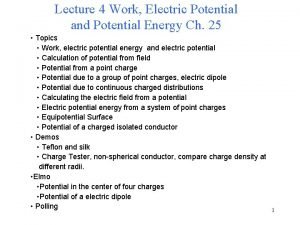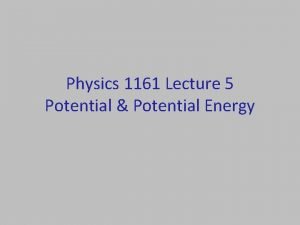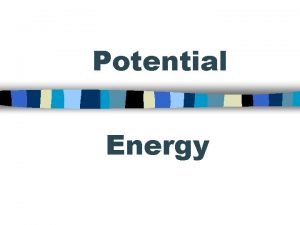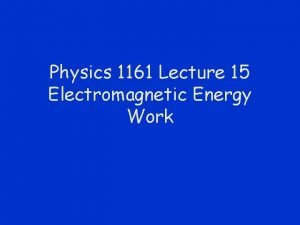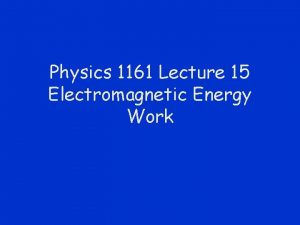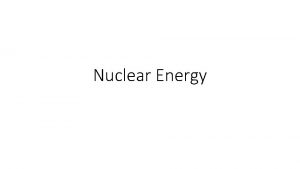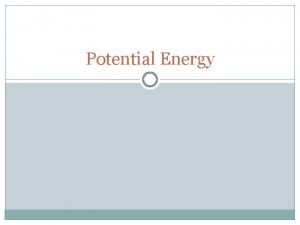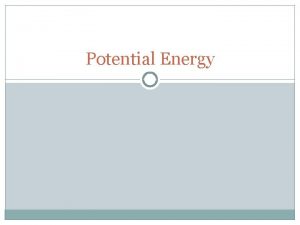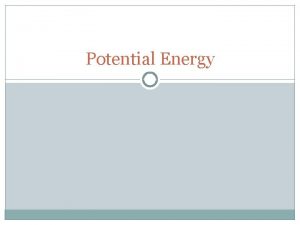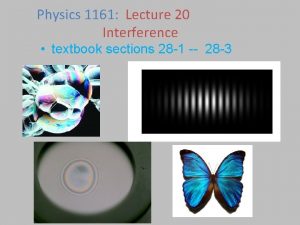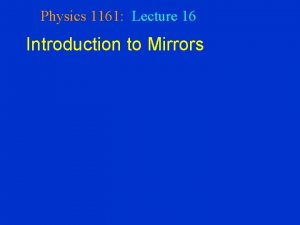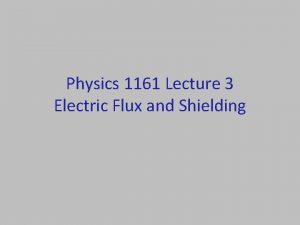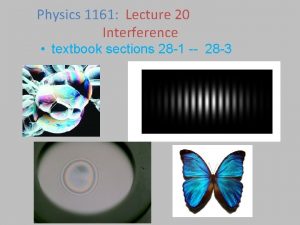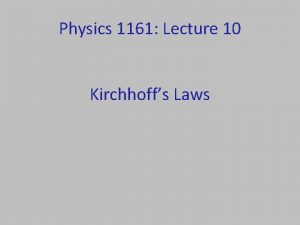Physics 1161 Lecture 4 Potential Potential Energy Recall





















- Slides: 21

Physics 1161 Lecture 4 Potential & Potential Energy

Recall Work from Phy 1151 • Work done by the force given by: ØW = F d cos(θ) ØPositive: Force is in direction moved ØNegative: Force is opposite direction moved ØZero: Force is perpendicular to direction moved • Careful! Ask WHAT is doing work! ØOpposite sign for work done by you! • Conservative Forces Ø Δ Potential Energy = -Wconservative

Preflight 5. 1 F In what direction does the force on a negative charge at point A point? 58% 1) left 39% 2) right 3% 3) up Electric field points in the direction a POSITIVE charge would feel force.

Preflight 5. 2 The work is zero because the path is perpendicular to the field F F F motion - C A B Uniform E When a negative charge is moved from A to C the ELECTRIC force does 37% 1) positive work. 45% 2) zero work. 18% 3) negative work.

Preflight 5. 3 The work is negative the electric force opposes the direction of motion C F - A F - F - F B - Uniform E motion When a negative charge is moved from A to B the ELECTRIC force does 32% 1) positive work. 24% 2) zero work. 43% 3) negative work.

Preflight 5. 5 C A - B - - Uniform E When a negative charge is moved from A to B, the electric potential energy of the charge 33% 1) Increases 33% 2) is constant 33% 3) decreases UE = -WE field Like “climbing up hill” – increases potential energy

When a negative charge is moved from A to B, the electric potential energy of the charge 1. increases 2. is constant 3. decreases + C B A

When a negative charge is moved from A to B, the electric potential energy of the charge 1. increases 2. is constant 3. decreases + C B A

Electric Potential Energy + E AC: W=0 C B A - - CB: W<0 - When a negative charge is moved from A to B, the electric potential energy of the charge (1) increases (2) is constant (3) decreases 1) The electric force is directed to bring the electron closer to the proton. 2) Since the electron ends up further from the proton the electric field did negative work. 3) So the electric potential energy increased

Work and D Potential Energy W = F d cos(q) Gravity • Brick raised yi yf • FG = mg (down) • WG = -mgh • UG= +mgh yf h yi Electric • Charge moved ∞ rf • FE = kq 1 q 2/r 2 (left) • WE = -kq 1 q 2/rf • UE= +kq 1 q 2/rf rf

Preflight 5. 11 1 5 m 2 + + 5 m The electric potential energy of this set of charges is: 55% (1) positive 26% (2) zero 18% (3) negative Bring in (1): zero Bring in (2): positive Bring in (3): negative x 2 5 m - 3

Electric Potential (like height)* • Units Joules/Coulomb Volts v. Batteries v. Outlets v. EKG • • Really Potential differences Equipotential lines at same height Field lines point down hill V = k q/r (distance r from charge q) v. V(∞) = 0

Preflight 5. 7 To go from B to A, a positive charge must climb “up hill” – increases potential energy. Hence A is at higher potential than B The electric potential at point A is _______ at point B 38% 1) greater than 32% 2) equal to 30% 3) less than

Preflight 5. 9 conductor The electric potential at point A is _______ at point B 8% 1) greater than 81% 2) equal to 11% 3) less than The electric field is zero at any point within a conducting material

The electric potential at A is _______ the electric potential at B. 1. greater than 2. equal to 3. less than ++ C B A

The electric potential at A is _______ the electric potential at B. 1. greater than 2. equal to 3. less than ++ E C B A 1) Electric field lines point “down hill” 2) AC is equipotential path (perpendicular to E) 3) CB is down hill, so B is at a lower potential than (“down hill from”) A

Electric Potential due to Proton What is the electric potential a distance r = 0. 53 10 -10 m from a proton? (Let V( ) = 0) What is the electric potential energy of an electron a distance r = 0. 53 10 -10 m from a proton? rf = 0. 5 10 -10 m + -

Comparison: Electric Potential Energy vs. Electric Potential • Electric Potential Energy (U) - the energy of a charge at some location. • Electric Potential (V) - found for a location only – tells what the EPE would be if a charge were located there (usually talk about potential differences between two locations): U = q. V • Neither has direction, just location. Sign matters!

Two Charges – Calculate V from +7 m. C charge – Calculate V from – 3. 5 m. C charge – Add (EASY!) A V 7 = 1. 26 x 104 V V 3 = -0. 63 x 104 V 4 m • Calculate electric potential at point A due to charges • V = kq/r Vtotal = 0. 63 x 104 V Q=+7. 0μC How much work do you have to do to bring a 2 μ C charge from far away to point A? 6 m Q=-3. 5 μ C W=ΔU= ΔVq = 1. 26 x 104 V

In the region II (between the two charges) the electric potential is 1. always positive 2. Positive at some points, negative at others 3. Always negative I II Q=+7. 0 m. C III Q=-3. 5 m. C

In the region II (between the two charges) the electric potential is 1. always positive 2. Positive at some points, negative at others 3. Always negative I II Q=+7. 0 m. C III Q=-3. 5 m. C Very close to positive charge potential is positive Very close to negative charge potential is negative
 Physics 03-01 work and the work-energy theorem
Physics 03-01 work and the work-energy theorem Electric potential units
Electric potential units Electrical potential energy
Electrical potential energy Pe=-qed
Pe=-qed 01:640:244 lecture notes - lecture 15: plat, idah, farad
01:640:244 lecture notes - lecture 15: plat, idah, farad Formula for energy
Formula for energy Gravity and kinetic energy
Gravity and kinetic energy Potential energy examples
Potential energy examples Sample of mechanical energy
Sample of mechanical energy Gravitational potential energy vs kinetic energy
Gravitational potential energy vs kinetic energy Potential energy vs kinetic energy
Potential energy vs kinetic energy Potential energy examples
Potential energy examples Types of potential energy
Types of potential energy Gravitational potential energy
Gravitational potential energy Formula of potential energy
Formula of potential energy Classical mechanics
Classical mechanics What is a harmonic wave in physics
What is a harmonic wave in physics Phy101 lecture 1
Phy101 lecture 1 Physics 101 lecture notes pdf
Physics 101 lecture notes pdf Wave motion physics notes pdf
Wave motion physics notes pdf Atmospheric physics lecture notes
Atmospheric physics lecture notes Electric potential lecture
Electric potential lecture





















